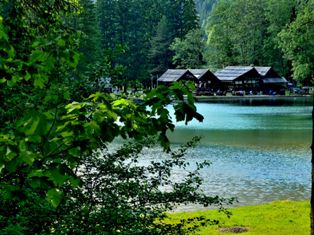
Starting point
We started cycling in the town of Preddvor, which is also known by its small lake and the castle next to it. We have chosen a less traffic paved road through the village under the mountain Storžič. The path leads through the Preddvor to the west towards the villages of Zgornja Bela, Bašelj and Trstenik. Slightly hilly road between meadows revenge with panoramic view to the Kranj plane and view to the Julian Alps and Triglav.
From Wikipedia, the free encyclopedia: The Loibl Pass (German: Loiblpass) or Ljubelj Pass (Slovene: prelaz Ljubelj)46°26′30″N 14°15′19″E / 46.44167°N 14.25528°E (elevation 1,367 m (4,485 ft)) is a high mountain pass in the Karavanke chain of the Southern Limestone Alps, linking Austria with Slovenia. The century-old pass near the Stol summit is the shortest connection between the Carinthian town of Ferlach and Tržič in Upper Carniola.
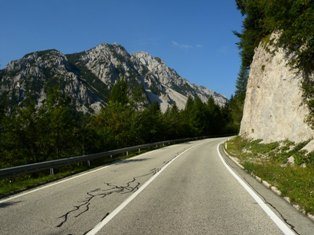 First mountain pass - Loibl Pass
First mountain pass - Loibl Pass
The ascent to the saddle Ljubelj begins and the the small town of Trzic. Follow the road signs to "Ljubelj". The road beginngs with a slight inclination enabling us quick cycling in the elongated valley of village Podljubelj. Conditions was tightened in the upper part of ascent where we cycled through the steep road, and dark tunnel through which runs a torrential watersheds. Quite noisy tunnel with fast traffic and no lights is a dangerous section for cyclists. We had to press to a pedal of bicycles. The inclination of road is at the last part some lower and before us we already saw the border with Austria and the entrance into the tunnel.
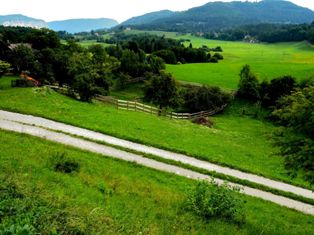 Cycling close the river of Drau - Austria Carithia
Cycling close the river of Drau - Austria Carithia
Now follows a deep and rapid descent into a region of Carinthia. Good brakes of bicycles was welcomed. Stop for a moment at a section of Tschepaschlucht gorge and take a look into a deep ravine of the wild nature.
The picturesque town of Ferlach is the beginning of mostly flat part of the way through the villages next to the river Drau (Drawa - Slovene). Slightly longer ascent begins in the city Dobrowa, but it is only an overture to a long climb from the town of Eisenkappel to the top of Seeberg (Jezersko). Follow the road signs to Eisenkappel or Seeberg.
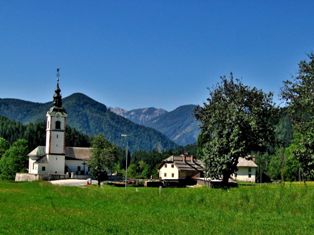 Ascent to the Seeberg pass (Jezersko pass)
Ascent to the Seeberg pass (Jezersko pass)
From Wikipedia, the free encyclopedia: Seebergsattel (German) or Jezerski vrh (Slovene), 46°25′N 14°31′E / 46.417°N 14.517°also just Seeberg or Jezersko, with the altitude of 1,218 metres (3,996 ft), is a high mountain pass connecting the Austrian state of Carinthia with the Slovenian region of Carinthia. The Seeberg Highway (B 82) heads from the Austrian side through the scenic village of Bad Eisenkappel up to the border crossing on the pass. Directly behind the Slovenian border station on a bank is an inn. On the Slovenian side, the pass descends from the Seeberg down into Jezersko, from which there is a superb view of the Kamnik Alps. The Seebergsattel is also known as the Carinthian Seeberg to differentiate it from the Styrian Seeberg elsewhere in Austria.
At Bad Eisenkappel stop at the moment and fill the water, take a deep breath and press to the pedal. Now, following the 14 km of road with over 600 meters of ascent. For a break, stop at the source of water, which is extremely rich in iron. The road climbed into serpentines to the summit of Jezersko pass. Motorcyclists race past you and enjoyable laying curves while the cyclists sweat drops of sweat .. however, the top is here ..
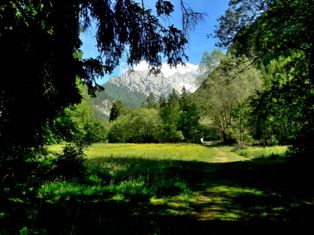 To the Alpine Lake of Jezersko country
To the Alpine Lake of Jezersko country
Take a time for well-deserved rest and lunch in a peaceful environment of Planšarsko jezero (Alpine Lake). We rode over 100 km and more than 2400 m altitude. Alpine Lake is artificial - dammed by the locals in memory of the great glacial lake, after which it got its name. It is certainly the most attractive point of the place and its some kind of a symbol. On the place of the old church of Sv. Oswald was previously a wooden chapel as a sanctuary for travelers and monks in the year 811, built by the end of the twelfth and early thirteenth century. It is famous by the statue of Mary which was donated in 1386 by patriarch Francis.